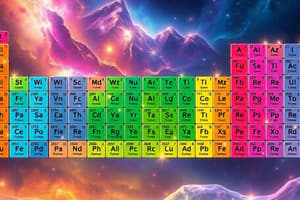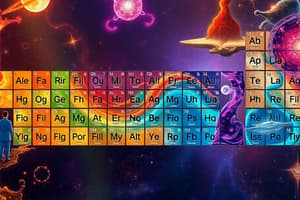Podcast
Questions and Answers
What is a periodic table?
What is a periodic table?
- A table displaying only metals
- A collection of elements arranged by atomic weight
- A list of chemical compounds
- A chart of all chemical elements organized by their properties (correct)
PERIODS on the periodic table are ____________
PERIODS on the periodic table are ____________
horizontal rows
GROUPS (FAMILIES) on the periodic table are __________
GROUPS (FAMILIES) on the periodic table are __________
vertical columns
All elements in the same group or family _________
All elements in the same group or family _________
What are alkali metals?
What are alkali metals?
Describe alkaline earth metals.
Describe alkaline earth metals.
What characterizes the nitrogen family?
What characterizes the nitrogen family?
What are the characteristics of the boron family?
What are the characteristics of the boron family?
What defines the carbon family?
What defines the carbon family?
What are transition metals?
What are transition metals?
Describe the oxygen family.
Describe the oxygen family.
What are halogens?
What are halogens?
What defines noble gases?
What defines noble gases?
What are rare earth metals?
What are rare earth metals?
What characterizes actinides?
What characterizes actinides?
Flashcards are hidden until you start studying
Study Notes
Periodic Table Overview
- The periodic table displays all known chemical elements, organized based on their properties.
Rows and Columns
- The horizontal rows are called Periods.
- The vertical columns are referred to as Groups or Families.
Element Properties
- Elements within the same group or family share similar reactivity and properties.
Alkali Metals (Group 1)
- Soft, silvery metals that are highly reactive, especially with water, leading to alkaline solutions.
Alkaline Earth Metals (Group 2)
- Shiny, silvery-white metals that possess moderate reactivity.
Nitrogen Family (Group 15)
- Mostly solid at room temperature (with nitrogen as an exception), conductivity increases down the group and they form stable bonds.
Boron Family (Group 13)
- Comprises soft metals with low melting points and exhibits good electrical conductivity, excluding Boron.
Carbon Family (Group 14)
- Shows increasing metallic properties down the group, generally has lower melting and boiling points.
Transition Metals (Groups 3-12)
- Known for their shiny appearance and diverse bonding capabilities with other elements.
Oxygen Family (Group 16)
- Typically soft materials with poor conductivity; metallic characteristics increase down the group alongside melting and boiling points.
Halogens (Group 17)
- Composed of poisonous, colored gases that exist as diatomic molecules and are common in cleaning agents (e.g., bleach).
Noble Gases (Group 18)
- Colorless, monatomic, and unreactive gases; their chemical inactivity makes them suitable for use in light bulbs.
Lanthanides
- Rare earth metals located in the second to last row of the periodic table, naturally occurring elements.
Actinides
- Rare earth metals found in the last row of the periodic table, which are not typically found in nature and are all radioactive.
Studying That Suits You
Use AI to generate personalized quizzes and flashcards to suit your learning preferences.




